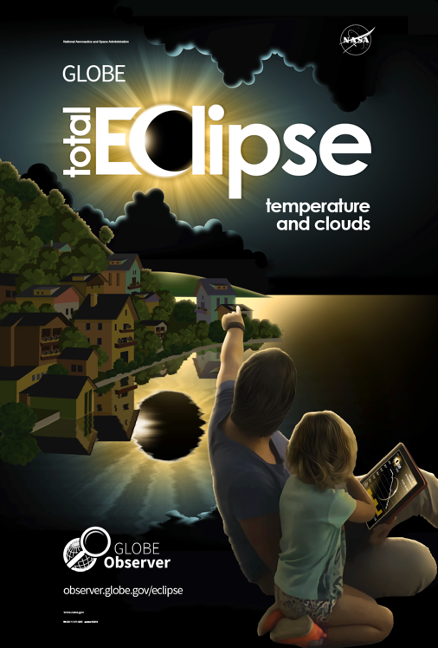Media Kit - GLOBE Observer
The Earth Science Angle: Study the upcoming total solar eclipse as a volunteer observer with The GLOBE Program
Short link to this page: https://observer.globe.gov/eclipse-media-kit
Science questions:
Energy from the Sun warms our planet, and changes in sunlight can also cause changes in temperature, clouds, and wind. What happens when the Sun is blocked by the Moon during an eclipse? How will the eclipse affect these solar-powered processes?
Using the GLOBE Eclipse tool, volunteer scientists are able to:
- Observe how the eclipse changes atmospheric conditions near them by reporting on clouds and air temperature (with a simple meteorological thermometer)
- Report surface conditions (photograph and describe the landscape) that may have an impact on differences in the atmospheric effects in varying locations
- Contribute to a citizen science database used by scientists and students to study the effects of eclipses on the atmosphere
- Provide comparison data even if not within the path of totality
Science background:
Data collected during the 2017 total solar eclipse showed a strong correlation between total cloud cover and temperature changes within the path of totality, with areas that had the most cloud cover experiencing the smallest temperature change during the eclipse. The team now will use cloud and air temperature observations collected during the recent annular eclipse and the upcoming total solar eclipse to study how cloud cover changes during these two astronomical events in different climate regions along the paths of maximum obscuration. It's especially helpful to have clouds observations and air temperature measurements throughout the period of the eclipse, from an hour or two before totality/maximum eclipse until an hour or two after.
Why:
Clouds play a significant role in regional and global climate. Cloud type and distribution is changing in a changing climate. Eclipses provide a natural experiment in which solar energy is removed from the atmosphere for a brief period of time. This allows scientists to see the impact on cloud cover in different climatic regions.
How:
- Anyone age 13 or older can use the GLOBE Observer app. Younger children may collect eclipse data with a parent or teacher
- The app is free in Google Play or the Apple App Store
- Training is in the app, so no prior experience is necessary
- The GLOBE Eclipse tool is currently available in the GLOBE Observer app. Live data entry began on April 1. This will allow volunteers to preview the protocol and practice using the tool ahead of April 8. From April 9 to May 9, the tool will be in review mode, allowing the eclipse data to be viewed, but no new data collected.
- Also participate in the GLOBE Eclipse Challenge: Clouds and Our Solar-Powered Earth from March 15 to April 15 to build the long-term record of cloud observations and help scientists study change over time.
Sample Social Media Text:
In addition to the graphic assets among the resources below, here is sample post text specifically for the GLOBE Eclipse Challenge (available as a downloadable social media kit with shareables).
Version 1:
(LONG):
Changes in heat lead to changes in the clouds, especially the types of clouds. To study these changes, you can make observations with The GLOBE Program’s GLOBE Observer app at different times throughout the day, week, month, and year from the same location. Changes can even be observed during astronomical events like a total solar eclipse (coming April 8, 2024). Join the GLOBE Eclipse Challenge: Clouds and Our Solar-Powered Earth now through April 15th. Learn more and download the GLOBE Observer app to participate today: https://observer.globe.gov/eclipse-challenge #EclipseChallenge
(SHORT):
Changes in heat lead to changes in the clouds. Changes can even be observed during a total solar eclipse (coming April 8, 2024). Join the GLOBE Eclipse Challenge: Clouds and Our Solar-Powered Earth now through April 15th. Learn more and download the GLOBE Observer app to participate today: https://observer.globe.gov/eclipse-challenge #EclipseChallenge
Version 2:
(LONG):
Would you like to help study the eclipse happening on April 8th? Yes? To do so, you can take part in the GLOBE Eclipse Challenge: Clouds and Our Solar-Powered Earth. Simply download the "GLOBE Observer" app and start taking observations of clouds each day leading up to, during, and after the eclipse. You can read more information on how to participate here: https://observer.globe.gov/eclipse-challenge #EclipseChallenge
(SHORT)
Would you like to help study the April 8 eclipse? If your answer is yes, then join the GLOBE Eclipse Challenge: Clouds and Our Solar-Powered Earth. Simply download the "GLOBE Observer" app and start taking observations of clouds today. More: https://observer.globe.gov/eclipse-challenge #EclipseChallenge
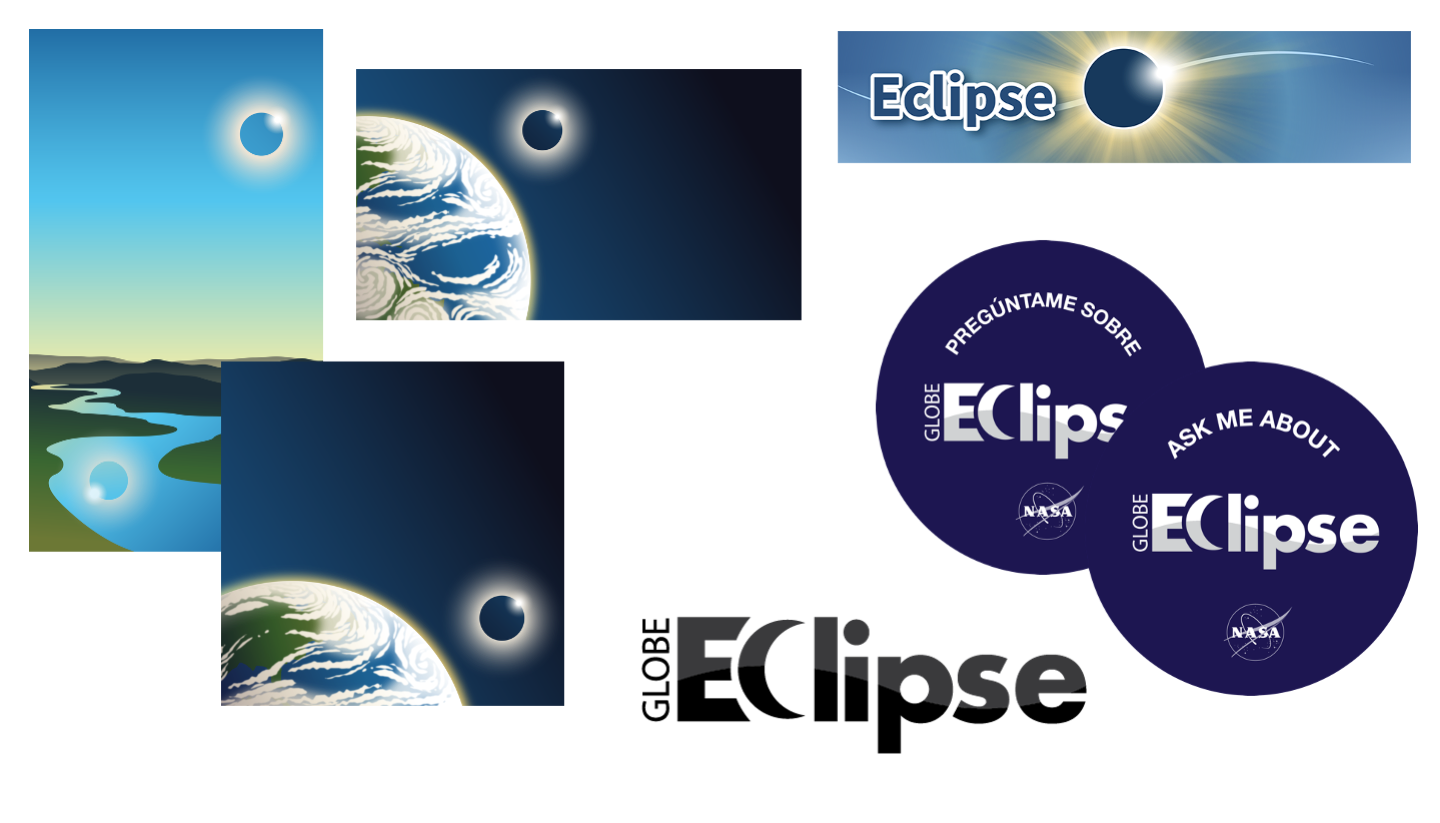
A selection of graphics assets related to GLOBE Eclipse, suitable for making custom presentations and social media posts. A zipped folder (19.6 MB) with: backgrounds to create shareables sized for Facebook, X, and Stories/Reels; two sizes of the app selector button art; text logos saying GLOBE Eclipse in white and black; and round signs that say "Ask Me About ... GLOBE Eclipse" and "Pregúntame sobre ... GLOBE Eclipse"
Sample shareables (Facebook and X formats, in both English and Spanish)
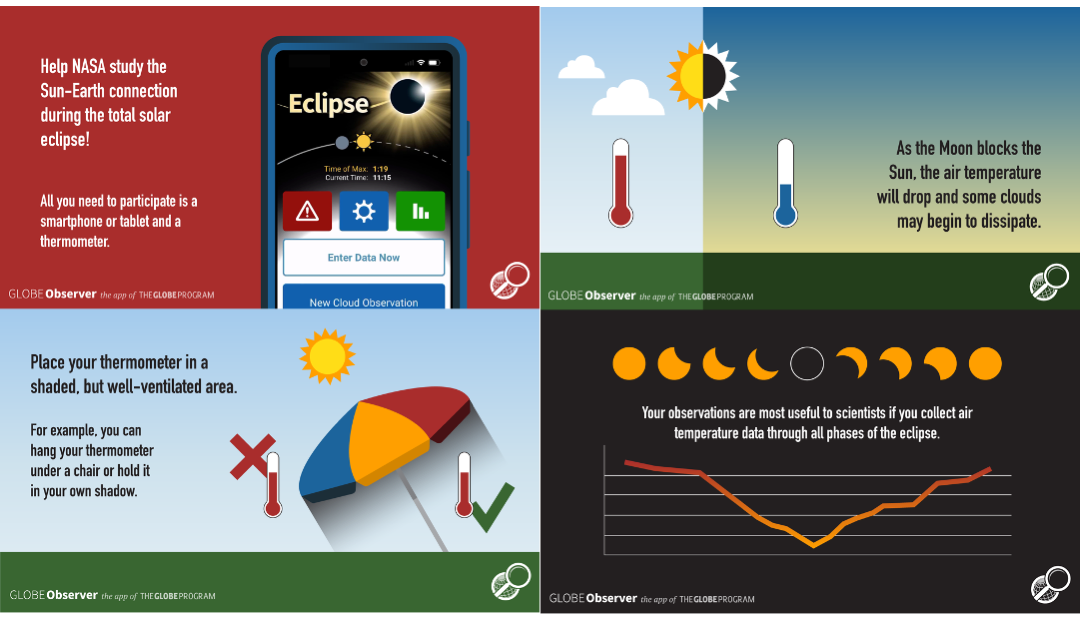
A set of graphics giving the basics about how to use the Eclipse tool for observations. Includes a document with suggested alternate text for the images.
Eclipse media graphics, PNGs plus a PDF with alt text (zipped folder, 1.5 MB)
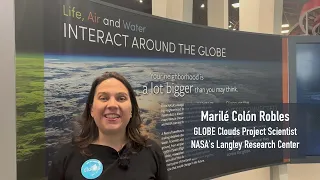
An introductory video for GLOBE Eclipse observations and the GLOBE Eclipse Challenge: Clouds and Our Solar-Powered Earth.
Download English Video [47.5 MB]
English Video on YouTube [1:07]
Download Spanish Video [56.8 MB]
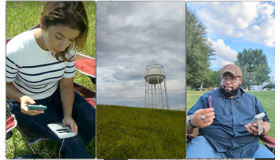
Various b-roll images related to GLOBE Eclipse, including using the app, finding and observation spot and setting up a thermometer, taking air temperature and clouds observations, putting on eclipse glasses, several timelapse images with clouds, and a scientist presenting an eclipse poster at a conference. Credit can be given to The GLOBE Program or simply GLOBE.
Horizontal B-roll footage (MP4 format, 01:32, horizontal orientation 1920 x 1080, 211 MB)
Vertical B-roll footage (MP4 format, 06:13, vertical orientation 608 x 1080, 272 MB)

Short reels, each under a minute, describing various aspects of using the GLOBE Eclipse tool and the Eclipse Challenge. Note: Some of these are versions of the reels with the end title indicating the annular eclipse in October 2023, but will be replaced with new version for the total solar eclipse as soon as they are available. (Spanish versions of these reels can be found in the Spanish resources section.)
Eclipse Challenge, Observations with GLOBE Observer [0:50]
Satellites and the Sun-Earth Connection [1:00]
Taking Eclipse Observations with GLOBE Observer! [0:55] (annular version)
How to Observe the Eclipse with GLOBE Observer [0:55] (annular version)
Using a Thermometer to Observe the Eclipse [0:51] (annular version)
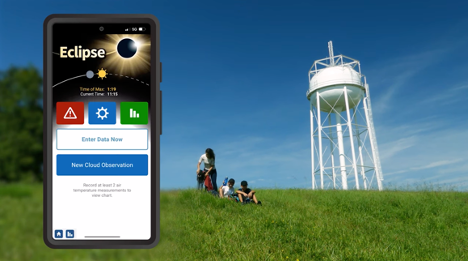
How to Observe with GLOBE Eclipse
[2:47] This video goes through the steps to participate in data collection, from selecting an air temperature thermometer to setting up the GLOBE Observer app, as well as how to watch the eclipse safely (you will need solar viewing glasses or an indirect viewing method for all but the brief few minutes of totality.)
Video in reel format, English [vertical, 0:55]
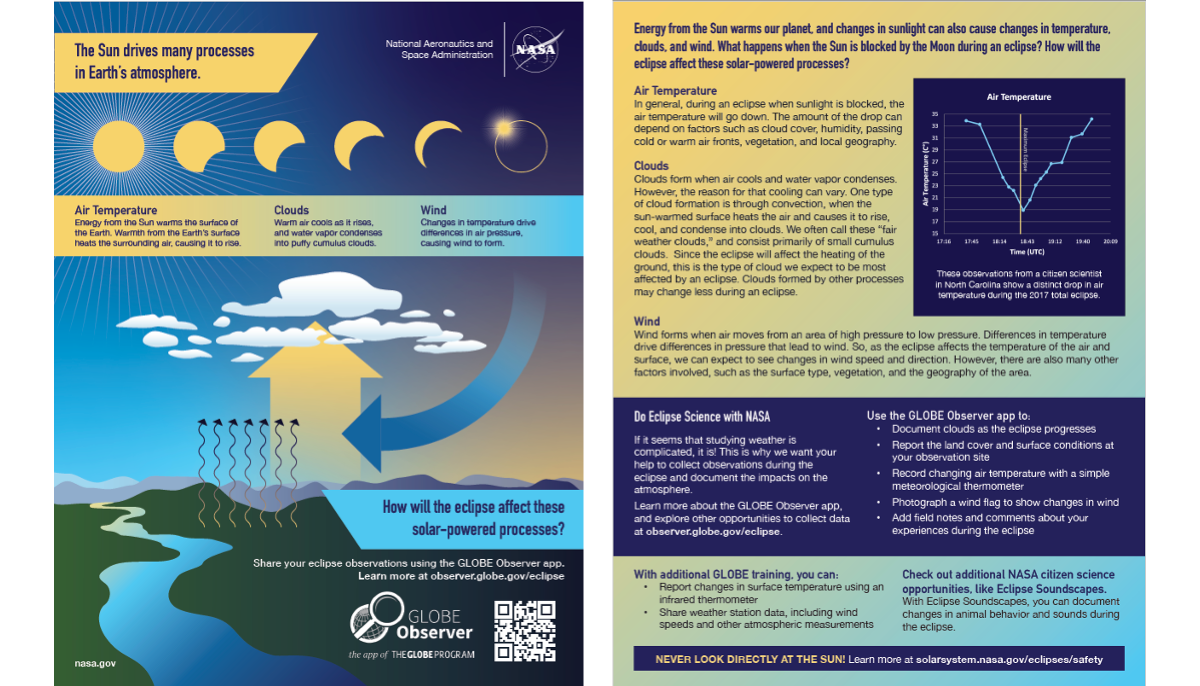
GLOBE Eclipse Atmosphere One-Pager
Energy from the Sun warms our planet, and changes in sunlight can also cause changes in temperature, clouds, and wind. What happens when the Sun is blocked by the Moon during an eclipse? How will the eclipse affect these solar-powered processes? This one-pager describes some the changes in the atmosphere you might observe during eclipses, and ways you can collect data during the events.
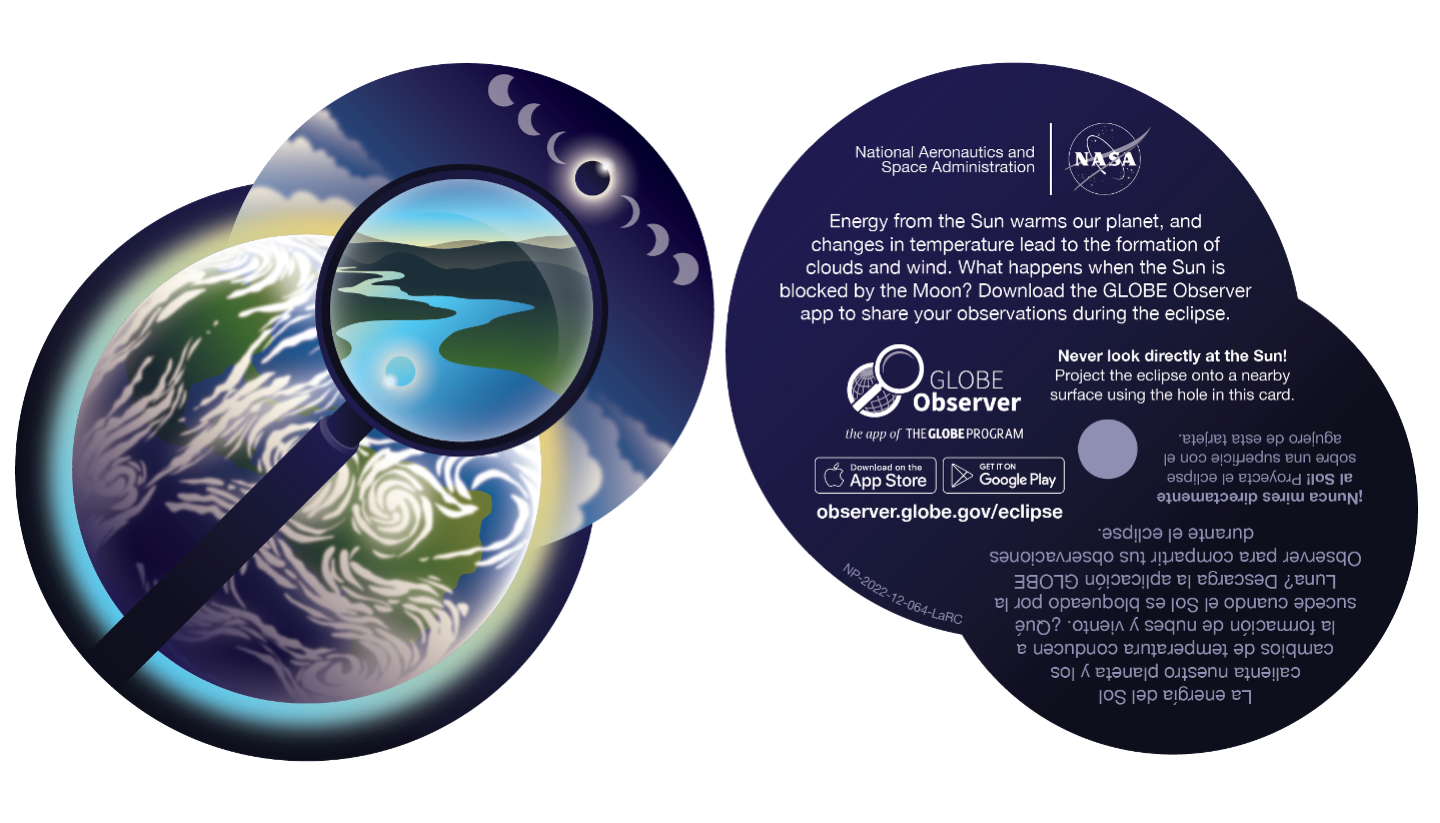
GLOBE Eclipse Pinhole Postcard
Dual-language (English and Spanish) postcard about observing the eclipse with GLOBE Observer, with a space in the middle that can be punched out to use as a pinhole projector. The text reads: "Energy from the Sun warms our planet, and changes in temperature lead to the formation of clouds and wind. What happens when the Sun is blocked by the Moon? Download the GLOBE Observer app to share your observations during the eclipse. Never look directly at the Sun! To use the card to view the eclipse indirectly, stand with your back to the Sun and look at the card's shadow. The shape of the hole in the shadow will mirror the shape of the eclipsed Sun.









